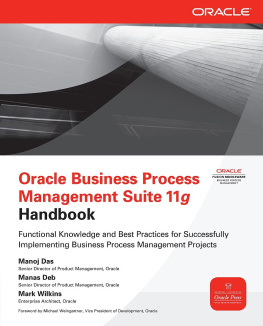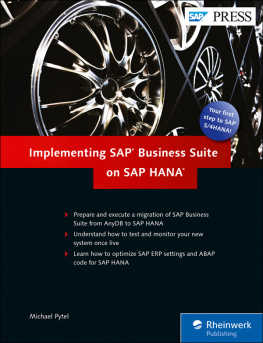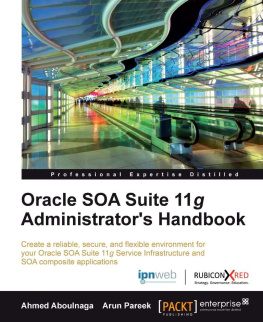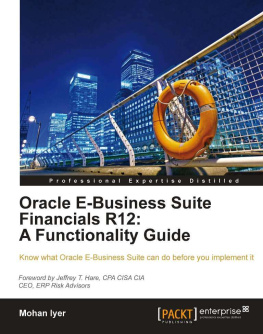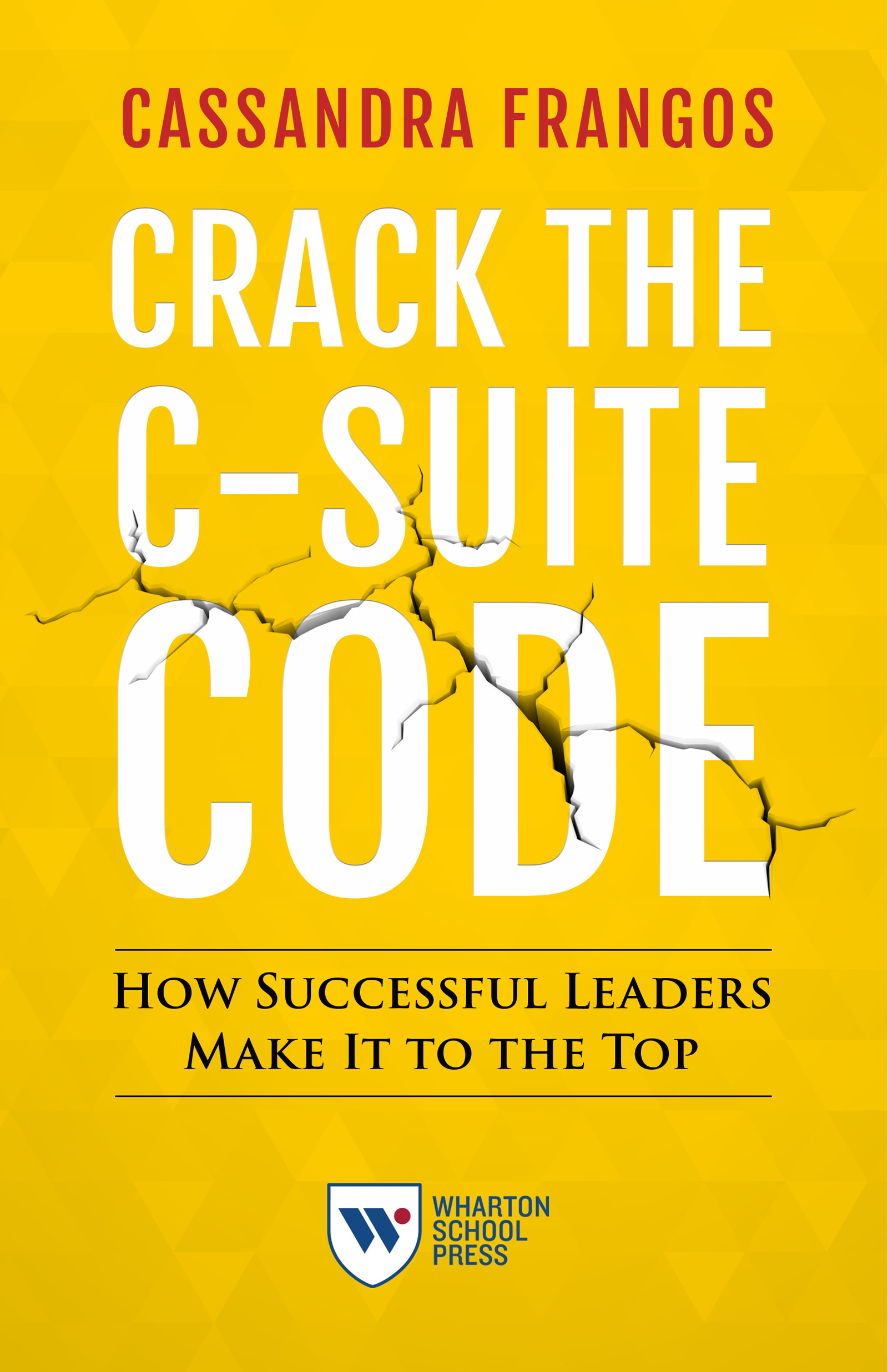Contents
Guide
Pagebreaks of the print version
Praise for Crack the C-Suite Code
2018 DIGITAL BOOK AWARD BEST BUSINESS BOOK FINALIST
In this compact book, Frangos focuses on the Holy Grail of the C-suite, which sits at the pinnacle of every professional career, and lays out not only a variety of reasons why people might want to achieve that goal, but also an assortment of methods for attaining it. A lean and bracingly straightforward look at the core paths to the executive suite.
Kirkus Reviews
If youve ever wanted to really figure out how to ascend to the C-suite, this is your Rosetta Stone. Based on in-depth research and case studies, Frangos identifies and quickly brings to life the four key routes to the top. A must-read for all aspiring executives!
James M. Citrin, Leader, Spencer Stuart CEO Practice, and Author, Youre in Charge, Now What?
Frangos has created a roadmap for executives on the fast track. With concrete depth, she lays out the tactics that guarantee a spot on the top team.
Sylvia Ann Hewlett, Author, Forget a Mentor, Find a Sponsor and Executive Presence
Stories straight from CEOs combined with expert advice make this a true insiders guide. The framework provided by Frangos is clearly understood, practical and rooted in real-world insights, making this book a powerful tool for students and executives alike as they strategically map out the future of their careers.
Boris Groysberg, Professor of Business Administration, Harvard Business School
With insightful advice and input from scores of C-suite executives, Frangos creates a roadmap for professional success that is both compelling and entertaining.
David P. Norton, Co-founder, The Palladium Group, and Co-creator, Balanced Scorecard Collaborative
CASSANDRA FRANGOS
CRACK THE
C-SUITE
CODE
H OW S UCCESSFUL L EADERS M AKE I T TO THE T OP

2018 by Cassandra Frangos
Published by Wharton School Press
The Wharton School
University of Pennsylvania
3620 Locust Walk
2000 Steinberg Hall-Dietrich Hall
Philadelphia, PA 19104
Email:
Website: http://wsp.wharton.upenn.edu
All rights reserved. No part of this book may be reproduced, in any form or by any means, without written permission of the publisher. Company and product names mentioned herein are the trademarks or registered trademarks of their respective owners.
Ebook ISBN: 978-1-61363-085-3
Paperback ISBN: 978-1-61363-084-6
9 8 7 6 5 4 3 2
To all my friends (especially Laura Downing), family, mentors, and colleagues who helped me during the loss of my lovely mum, which coincided with the joy of writing this book.
Contents
Introduction
One Question, Four Answers
With so much changing in business, it is easy to recognize when something remains static.
Thats what happened to me a few years ago when I was coaching a senior executive at Cisco. He had joined the organization two months prior and was already working through his first-90-days agenda and earning respect from his peers. As we wrapped up a conversation about his goals, he sprung the career question I hear most commonly from executives who are hovering two to three levels from the top: So, what do you think I need to do to reach the C-suite?
In this case, the executives face became a little sheepish as he asked. Others inquire with intensity, in a deadly serious voice. Then there are those who lean in with a hushed, conspiratorial tone, as if entry into the C-suite requires some kind of secret code.
The question is common, though the circumstances in which it is asked vary widely. Executives want to reach the C-suite for different reasons. Some are extremely ambitious, and they see making the top team as the pinnacle of success. Others want to have greater impact and believe they can make a difference in the world working from the top. Neither of these reasons, nor any others I have heard, is wrong. Theyre just different.
In my role at Spencer Stuart, which entails collaborating with Fortune 500 leaders on executive assessments, succession planning, leadership development, and top-team effectiveness, I have had the chance to consider this question with great frequency. Previously, as former head of executive global talent and organizational development at Cisco, a company with 70,000 employees, I worked with the top team in numerous ways: successful executives planning their future, C-suite leaders orchestrating their succession, boards looking at the strength of the organizations leaders, executive recruiters looking for their next C-suite hire, and so on.
Most of my attention at Cisco, however, was spent interacting with two distinct groups. First, I worked with the top 500 leaders, conducting executive assessments, creating development plans, and attending to their coaching needs. They all wanted to succeed at Cisco, and my job was to help them advance or move on. Next, I partnered with the companys C-suite to help them develop leadership capabilities within their respective teams. Part of that involved putting succession plans into place. A few years ago, I worked with Ciscos board and our chief people officer to oversee the CEO succession process, when John Chambers handed the chief executive mantle to Chuck Robbins. That experience gave me a whole new lens through which to consider this question.
In my work at Spencer Stuart, as well as at Cisco, I have seen the race to the top team play out many times. Some years ago, I began to take notes and form my own conclusions about how to help people get there. Still, I needed to go deeper into the topic and get beyond my own experience. So my journey in exploration began. I talked to as many C-suite executives as I could, across industries over a multiyear period, at conferences and networking events, and over the course of my everyday job. I got in the habit of asking them to tell me their stories. Suddenly, I was the one asking the question, So, what did you do to reach the C-suite?
For this book, I formally interviewed dozens of CEOs and other C-suite executives from a broad range of companies and industries. After that, I surveyed 350 additional executives who are likely to be C-suite candidates in the future. I also interviewed the topmost experts in executive recruiting, leadership development, and management academia.
With this research and inquiry as the backdrop, I established a practical framework for how leaders make the leap into the C-suite. It helps that I have a keen interest in the intersection of psychology and business, which led me to pursue advanced degrees in education, psychology, and organizational development. My multidisciplinary background allowed me to piece together a coherent theory, despite the fact that the answer to the question at hand is somewhat different in every case.
When the executive I mentioned earlier asked his question, I answered it in the same way I always have: I dont know how youll reach the C-suite. Its different for everyoneyou need to find the right path.
And this book, Crack the C-Suite Code: How Successful Leaders Make It to the Top , will help you find your own path. It reveals the Four Core Paths to the C-suite and explains what experiences and career strategies will hasten your journey. As youll see, some of these paths entail introducing disruption into your career, while others require patience and tenacity. This combination of mastering the old and embracing the new mirrors business at large today, where leaders must remain ahead of change and complexity while they also steer everyday operations in a way that creates constancy.


